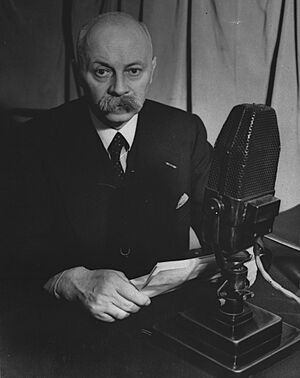Dutch government-in-exile facts for kids
Quick facts for kids
Dutch government-in-exile
Nederlandse regering in ballingschap
|
|||||||||
|---|---|---|---|---|---|---|---|---|---|
| 1940–1945 | |||||||||
| Status | Government in exile | ||||||||
| Capital | Amsterdam | ||||||||
| Capital-in-exile | London | ||||||||
| Government | Transitional government | ||||||||
| Queen | |||||||||
|
• 1940–1945
|
Wilhelmina | ||||||||
| Prime Minister | |||||||||
|
• 1940
|
Dirk Jan de Geer | ||||||||
|
• 1940–1945
|
Pieter Sjoerds Gerbrandy | ||||||||
| Historical era | World War II | ||||||||
| 15 May 1940 | |||||||||
| 5 May 1945 | |||||||||
|
|||||||||
The Dutch government-in-exile (Dutch: Nederlandse regering in ballingschap) was the official government of the Netherlands during World War II. It was also called the London Cabinet (Dutch: Londens kabinet). This government had to leave the Netherlands and move to London after Germany invaded their country on May 10, 1940. Queen Wilhelmina led this government from afar.
Why the Dutch Government Went into Exile
Before 1940, the Netherlands was a neutral country. This meant they did not take sides in wars. But on May 10, 1940, Germany invaded the Netherlands. The German army used a fast attack style called blitzkrieg.
Queen Wilhelmina left the country on a British ship. She arrived in London on May 13. The Dutch army surrendered two days later. In London, the Queen set up the Dutch government-in-exile. Their new base was Stratton House in the Piccadilly area.
At first, they hoped France would fight back and free the Netherlands. But this plan failed. Allied soldiers were surrounded and had to escape at Dunkirk. To keep the royal family safe, Princess Juliana and her family went to Canada. They stayed there for the rest of the war.
The government-in-exile soon faced a big problem. After France was defeated, a new French government took power. This government wanted to work with Adolf Hitler and Germany. The Dutch Prime Minister, Dirk Jan de Geer, thought the Netherlands should do the same.
But Queen Wilhelmina disagreed. The Dutch government still controlled the Dutch East Indies. This area had many valuable resources, especially oil. It was the third-largest oil producer in the world. The Queen knew that if the Netherlands worked with Germany, the Dutch East Indies might be given to Japan. This is what happened to French colonies.
Life in London for the Exiled Government

The Queen realized that the United States or the Soviet Union needed to join the war to help free the Netherlands. So, she removed Dirk Jan de Geer as prime minister. She chose Pieter Sjoerds Gerbrandy to take his place. Gerbrandy worked with leaders like Churchill and Roosevelt. They looked for ways to encourage the United States to join the war.
Places like Aruba and Curaçao were very important. They had oil refineries that made fuel for the Allies. Aruba became a British protectorate, then a US protectorate. In 1941, the United States also took control of Dutch Guiana. This was to protect its valuable bauxite mines. An oil boycott was put on Japan. This helped lead to the Pearl Harbor attack.
In September 1944, the Dutch government worked with the Belgian and Luxembourgish governments. They started planning a special agreement. This agreement would create a Benelux Customs Union. It was signed in London on September 5, 1944.
Queen Wilhelmina's strong actions were later approved by the Dutch parliament in 1946. After World War II ended, the Queen and her government returned home. They helped rebuild the Netherlands. The country became even more democratic than before.
See also
- Dutch resistance
- Netherlands in World War II
- Operation Neuland
- Radio Oranje




